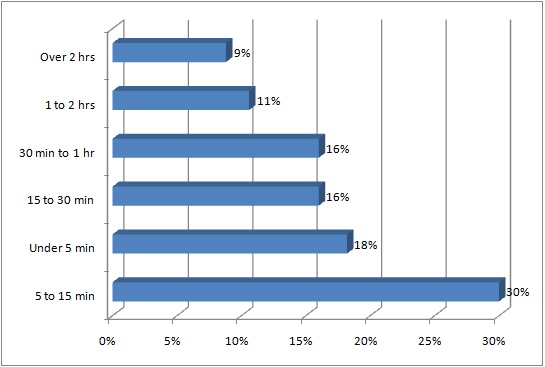Monthly Archives: March 2011
Video Duration: Does It Matter?
This is perhaps the most hotly debated and frequently asked question for online video producers. How long should the video be?
Most people, based on their personal experiences with varying video quality on the Web, think it should be as short as possible. I’ve heard opinions ranging from “under one minute” to “5-6 minutes” to “absolutely no more than 10 minutes.”
Surprisingly perhaps, some research (see the chart here from a recent Aberdeen study) suggests the typical viewer is actually quite tolerant, with the largest group (30%) comfortable viewing in the 5 to 15 minutes range.
This doesn’t mean, however, your videos should be that long. As always, the correct duration or length will be determined by the strength of your content and the viewers’ interest in it.
In many respects, this is like the age-old debate over whether advertising copy should be short or long. Direct marketing guru Bob Stone and others proved a long time ago that, paradoxically, lengthy ad copy could hold a reader’s interest as well or better than short copy if it was well written. Tom Reid, a mentor of mine in days’ past, used to tell folks who argued for short copy that he could write a 300-page book they wouldn’t be able to put down… their own life story, he would add.
All that said, tell your story in as little time as possible. Be brutal in editing it down and keep the messaging simple (remember the old reporter’s adage: “I would have written a shorter story if I had more time.”). For most videos, in my view, 5 to 10 minutes sounds about right.
Teleprompter or No Teleprompter?
The teleprompter (originated by the TelePrompTer company in the 1950s) is an indispensable component in modern-day television and video production, providing onscreen talent with a scrolling screen of words to speak. It saves many a babbler and stumbler from professional embarrassment. The question we often run across when doing Q&A-style interviews or video clips is, “do we need one”?
Yes, you do. Even when an interview-subject knows the topic cold or has handwritten notes in his or her lap, it can never come across as smooth and professional as it does with the teleprompter. First-timers, with a little bit of practice, get the hang of it easily and it’s fun to use. Now, there are a very rare few who can speak contemporaneously or off-the-cuff, and make it sound authoritative. Then, there is the other 99.9% of the population. So, use ’em if you’ve got ’em.
Another related issue is where to place the teleprompter… to the side of the camera or in front (using a “two-way” mirror)? In my opinion, particularly for Q&A video clips and most corporate-style videos, you want the teleprompter to the side. Watch any news program and you’ll see the interview-subject speaking to the reporter off-side. It’s more pleasing for the audience and easier for the interviewee.
But “no,” you say, “I want to look at my audience and give them the straight-goods. Look ’em in the eye just like a real conversation.” Forget it. Most interview-subjects have a tough time looking natural when staring into a camera. Their eyes dart side-to-side as they read the teleprompter. Or, they can’t bring themselves to blink. Very scary for viewers and often looks unnatural.
The one possible exception is when you are doing the equivalent of a reporter’s or presenter’s monologue (a “stand-up” as it’s called). Those occasions, however, are rare in most corporate videos.
So relax, enjoy the benefits of the teleprompter and enhance your reputation as an all-knowing and confident expert.
Quick Tip: Leave Your BlackBerry off the Set, Podium, etc.
Have you ever listened to a speech or watched a video and heard a strange crackling sound? Like radio interference?
Well, chances are it is the speaker’s BlackBerry (which is a radio device at heart). When you receive a message on a BB, it often creates signal interference with nearby audio equipment used for recording or capturing your voice. For recordists and audio purists, it is annoying and likely distracting for most folks if it happens a lot during a session. iPhone, Treo and other smartphone users don’t seem to have this issue.
So, put that BB aside when you are on-camera or speaking, and let your message come through loud and clear.
Online Video Streaming Soaring
Nielsen Media Research, the audience measuring service, reports that video streaming on the Internet is ramping up seriously. As of January 2011, year-over-year, video streaming itself is up 31.5% over 2010. That’s 14.5 billion video streaming sessions. Nielsen says even though the number of “unique video viewers” only rose 3.1% (i.e., a modest rise in the online population viewing), those same viewers streamed 28% more video than in the previous year. They also spent an average of 45% more time watching online video. Obviously, people are growing more comfortable with online video as a communications vehicle.
And, what types of videos? Not surprisingly, movies and music videos are among the most popular subject-matter. YouTube, with its mix of wacky and legitimate video clips, is the undisputed king of content delivery networks, with 8.5 billion video streams delivered, or 10 times that of its nearest competitor, Hulu.
